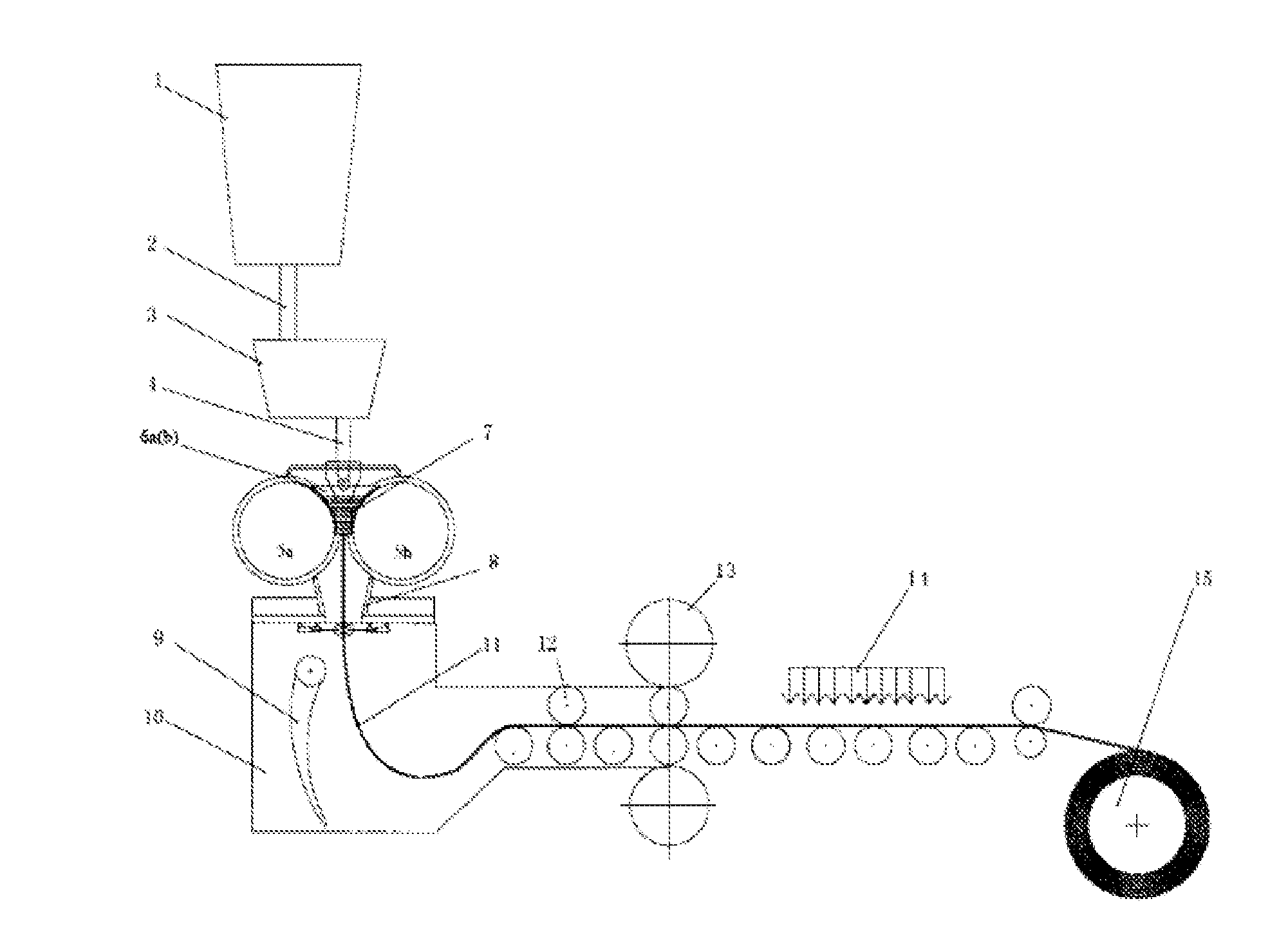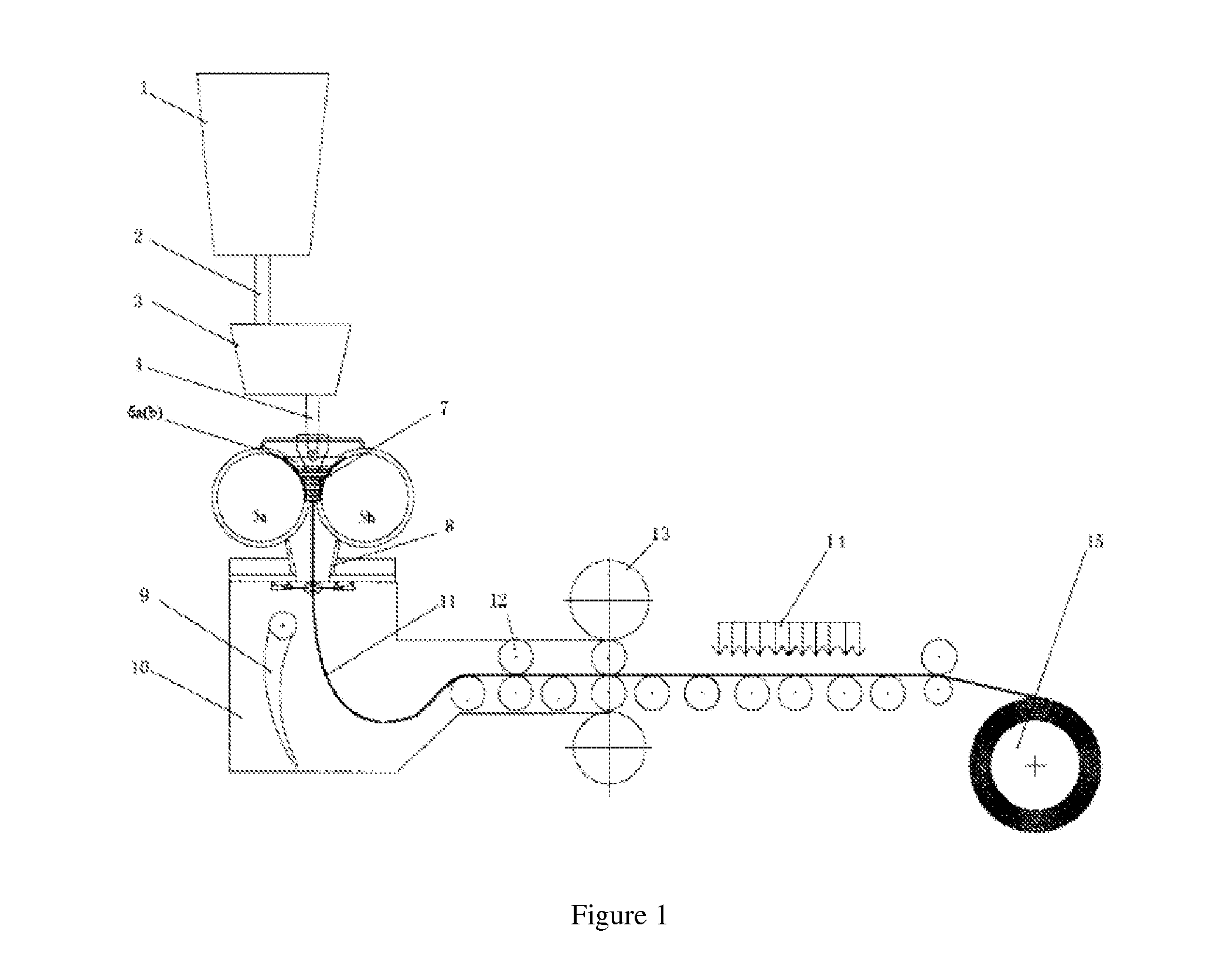However, there are the following main problems existing in the traditional
process manufacturing a microalloyed high-strength
atmospheric corrosion-resistant steel:(1) The manufacturing cost is high caused by long process flow,
high energy consumption, multiple unit equipment, high infrastructure construction cost;(2) Given that the atmospheric
corrosion-resistant steel contains relatively high contents of P, Cu and other easy-segregation elements which can improve the atmospheric
corrosion-resistant performance of the steel strip, the traditional process, due to the low solidification and
cooling rates of the
casting slab, may easily cause the macroscopic segregation of P, Cu and other elements, the
anisotropy, macroscopic
cracking and further low yield of the
casting slab;(3) The weather-resistant performance of the atmospheric corrosion-resistant steel is mainly determined by the combined action of P and Cu.
The result of said practice is the low weather-resistant performance of the steel strip;(4) In the traditional process, the microalloy elements cannot be kept in the form of
solid solution in the hot rolling process and usually go through partial
precipitation and led to the increase of steel strength, which thus significantly increases the rolling load, raises
energy consumption and roller consumption, causes significant damage to equipment and therefore limits the thickness range of the high-strength hot-rolled weather-resistant product which can be economically and practically manufactured (i.e., usually ≧2 mm).
However, the high strength of the hot-rolled steel strip may also result in difficulties in cold rolling, in that the high cold rolling load imposes a relatively high requirement on equipment and causes relatively significant damages and that the second phase segregated from the
alloy elements in the hot-rolled product significantly increases the recrystallization annealing temperature of the cold-rolled steel strip;(5) When manufacturing a high-strength product containing microalloy elements by the traditional process, the principle of refining
austenite grains through deformation is usually employed, thus, the initial rolling temperature of finishing rolling is usually lower than 950° C., and its final rolling temperature is around 850° C. Therefore, when rolling under a relatively low temperature and combined with the increase of deformation with the progress of the rolling process, the strength of the steel strip are significantly increased, thus, the difficulty and consumption of hot rolling are significantly increased.
The
thin slab continuous casting and rolling process enjoys said advantages in the manufacture of microalloyed high-strength atmospheric corrosion-resistant steel, however, some problems existing in the traditional process still persist in the thin slab continuous casting and rolling process.
For example, the microalloy elements cannot be kept in the form of
solid solution in the hot rolling process and usually go through partial
precipitation and lead to the improvement of steel strength, which thus significantly increases the rolling load, increases
energy consumption and roller consumption, therefore limits the thickness range of the high-strength hot-rolled
weathering-resistant product which can be economically and practically manufactured (i.e., thickness of 1.5 mm or above).
In comparison, in the traditional process, the
precipitation of these
alloy elements occurs in the cooling process of the slab, and an inadequate redissolution of these alloy elements will occur when the slab is reheated, as a result of which the
utilization rate of these alloy elements is reduced.
It is usually required to have a superior strength and
plasticity matching, so even on products with a relatively high strength grade a relatively high requirement is imposed with respect to their elongation, otherwise the requirements of the forming process cannot be met.
Moreover, the disclosure does not provide the temperature range adopted by the hot rolling, however, in papers related to these patents (C. R. Killmore, etc.
However, the key problem is the low elongation of the product, the cause of which is explained below.
If these
austenite grains are not refined through recrystallization, the inhomogeneous coarse austenite won't be effectively improved after hot rolling, and the
bainite+
acicular ferrite structure produced through the phase transformation of the inhomogeneous coarse austenite will also be extremely inhomogeneous, as a result of which the elongation of the product will be relatively low.
 Login to View More
Login to View More 

